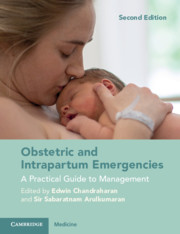Book contents
- Obstetric and Intrapartum Emergencies
- Obstetric and Intrapartum Emergencies
- Copyright page
- Contents
- Contributors
- Preface
- Preface to the First Edition
- Acknowledgements
- Section 1 General Principles
- Section 2 Algorithms for Management of the Top Five ‘Direct Killers’
- Section 3 Intrapartum Emergencies
- Section 4 Postpartum Emergencies
- Section 5 Medical and Surgical Emergencies During Pregnancy
- Section 6 Anaesthetic Emergencies During Pregnancy
- Chapter 32 General Anaesthesia and Failed Intubation
- Chapter 33 Fluid Overload and Underload
- Chapter 34 Transfusion and Anaphylactic and Adverse Drug Reactions in Pregnancy
- Chapter 35 Major Trauma Including Road Traffic Accidents
- Section 7 Neonatal Emergencies and the Management of Immediate Neonatal Problems
- Section 8 Management of Anticipated and Non-anticipated Emergencies in Pregnancy
- Section 9 Setting-Up Skills and Drills Training in Maternity Services and Reducing Avoidable Harm
- Index
- References
Chapter 34 - Transfusion and Anaphylactic and Adverse Drug Reactions in Pregnancy
from Section 6 - Anaesthetic Emergencies During Pregnancy
Published online by Cambridge University Press: 06 May 2021
- Obstetric and Intrapartum Emergencies
- Obstetric and Intrapartum Emergencies
- Copyright page
- Contents
- Contributors
- Preface
- Preface to the First Edition
- Acknowledgements
- Section 1 General Principles
- Section 2 Algorithms for Management of the Top Five ‘Direct Killers’
- Section 3 Intrapartum Emergencies
- Section 4 Postpartum Emergencies
- Section 5 Medical and Surgical Emergencies During Pregnancy
- Section 6 Anaesthetic Emergencies During Pregnancy
- Chapter 32 General Anaesthesia and Failed Intubation
- Chapter 33 Fluid Overload and Underload
- Chapter 34 Transfusion and Anaphylactic and Adverse Drug Reactions in Pregnancy
- Chapter 35 Major Trauma Including Road Traffic Accidents
- Section 7 Neonatal Emergencies and the Management of Immediate Neonatal Problems
- Section 8 Management of Anticipated and Non-anticipated Emergencies in Pregnancy
- Section 9 Setting-Up Skills and Drills Training in Maternity Services and Reducing Avoidable Harm
- Index
- References
Summary
Incidence Obstetric blood transfusion represents a small proportion of overall blood use. However, the use of blood products in obstetrics is rising as postpartum haemorrhage rates continue to increase.
There is evidence of increasing rates of maternal red blood cell transfusion during childbirth worldwide, mainly in the context of postpartum haemorrhage [1–4]. In the United States, there was a steep increase in peripartum transfusion (from 0.3% to 1.0%) between 1998 and 2009 [5].
Outside the context of major haemorrhage, there is little evidence for the benefit of blood transfusion in fit, healthy, asymptomatic patients. The decision to transfuse must be based on careful clinical assessment in conjunction with the haemoglobin level [6].
- Type
- Chapter
- Information
- Obstetric and Intrapartum EmergenciesA Practical Guide to Management, pp. 245 - 251Publisher: Cambridge University PressPrint publication year: 2021



